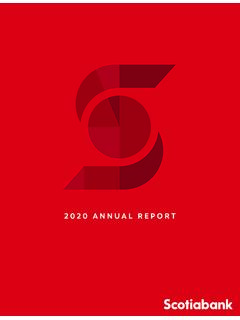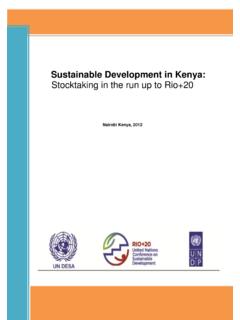Transcription of Global and local environmental sustainability, development ...
1 The United Nations (UN) and the international community are working on a new development framework to replace the Millennium development Goals (MDGs) after 2015 . This is expected to place environmental sustainability at its core by integrating the Sustainable development Goals (SDGs) agreed at the Rio+20 UN Conference on Sustainable development . The importance of environmental sustainability to development was captured in MDG 7. Despite some progress towards meeting this goal, there is still substantial unfinished business and new Global and local challenges endanger the development and environmental gains achieved so far.
2 The post- 2015 framework will need to reflect the linkages between poverty reduction, natural resource management and development , as well as local and Global environmental challenges. A key element will be to identify and address a common agenda to collectively manage shared Global environmental risks and to build resilience across all types of countries to contribute to inclusive and sustainable development , taking into account complex issues such as the interactions between food, water and energy security.
3 To implement this agenda, a wide range of policies and policy reforms will be needed to promote inclusive and environmentally sustainable growth and improve the well-being of all. The Organisation for Economic Co-operation and development (OECD) stands ready to champion implementation of the post- 2015 sustainable development agenda. It can do so by: Advancing coherent policies for sustainable development through integrated knowledge and practice; Championing a data revolution and harmonising statistics for the effective monitoring of development finance for climate, biodiversity and other environmental areas; Supporting and monitoring OECD country progress in implementing the post- 2015 SDGs via policy guidance, governance support and peer review assessments.
4 Strengthening and leading strategic international partnerships to share knowledge, promote policy reforms and bring communities together to exchange experience, information and lessons learnt in implementing the SDGs. Global and local environmental sustainability, development and growthOECD AND POST- 2015 REFLECTIONS Element 4, PAPER 1environmental sustainabilityGLOBAL AND local environmental SUSTAINABILITY, development AND GROWTH2 Why focus on environmental sustainability in the post- 2015 development agenda?
5 The UN High Level Panel of Eminent Persons on the Post- 2015 development Agenda as well as the report of the UN Secretary-General A life of dignity for all (UN, 2013a) and the Outcome Document of the UNGA 2013 (UN, 2013c) strongly advocate putting sustainable development at the core of the post- 2015 agenda (HLP, 2013). Their report highlights sustainability as one of the top five transformative shifts required to drive development . It proposes a range of integrated goals and indicators on governance, at sector level and on cross-cutting themes that relate to environmental sustainability.
6 The OECD s environmental Outlook to 2050 (OECD, 2012b) highlights the need for new models of development , centred on human well-being and the interface with the natural environment. It considers future social, environmental and economic costs and benefits of business-as-usual models of growth against alternative, more sustainable options. Without a change in policy, Global demand for natural resources is increasing, sometimes beyond the capacity of the environment to replenish itself.
7 By 2030, an additional 1 billion people are expected to live in severely water-stressed areas and Global terrestrial biodiversity is expected to decline an additional 10%, leading to a loss of essential ecosystem services. By 2050, growing levels of dangerous air emissions from transport and industry will increase the Global number of premature deaths linked to airborne particulate matter to million people a year, more than doubling today s levels. Failure to act could also lead to a 50% increase in Global greenhouse gas emissions by 2050 and Global mean temperature increases of 3-6 C by the end of the century, in turn contributing to more severe and sometimes more frequent natural disasters, such as heat waves, tropical cyclones, floods and landslides.
8 Further pressure on environmental planetary boundaries risks causing widespread, abrupt and possibly irreversible changes to basic Earth-system processes on which the well-being of present and future generations depends (Griggs et al. 2013). These pressures have already begun to undermine the foundation for growth and development . Failing to address these pressures threatens to reverse important gains made to date. Natural assets represent on average 26% of the wealth of developing countries compared to 2% in OECD economies (OECD, 2008).
9 This highlights the particular vulnerability of developing countries to natural assets mismanagement and loss, while their limited incomes and institutional capacity undermines their ability to adapt to environmental risks. Many developing country governments struggle to ensure access to clean water, energy and food security in the context of growing populations and rapid urbanisation. The challenge is made greater by growing Global environmental risks, from biodiversity loss and from unabated climate change.
10 At the national level, environmental degradation is already slowing economic growth and harming human health and well-being. Reconciling development with environmental protection and sustainable resource management is broadly agreed as a central concern for the post- 2015 development agenda. This recognises that sustainable development needs to foster economic growth while ensuring that natural resources continue to provide the resources and environmental services on which well-being relies (OECD, 2013a).Progress on environmental sustainability under the MDGsThe United Nation s Millennium development Goals (MDGs) comprise eight development goals to be achieved by 2015 .












